
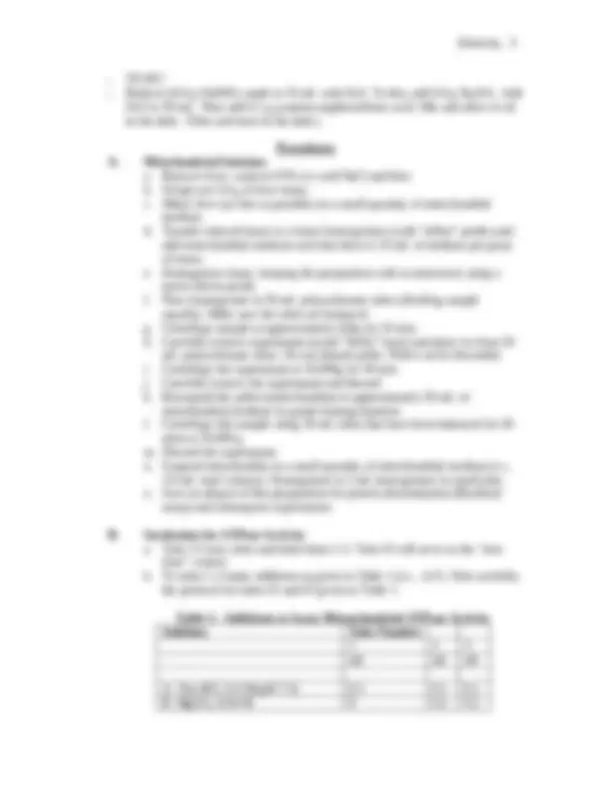
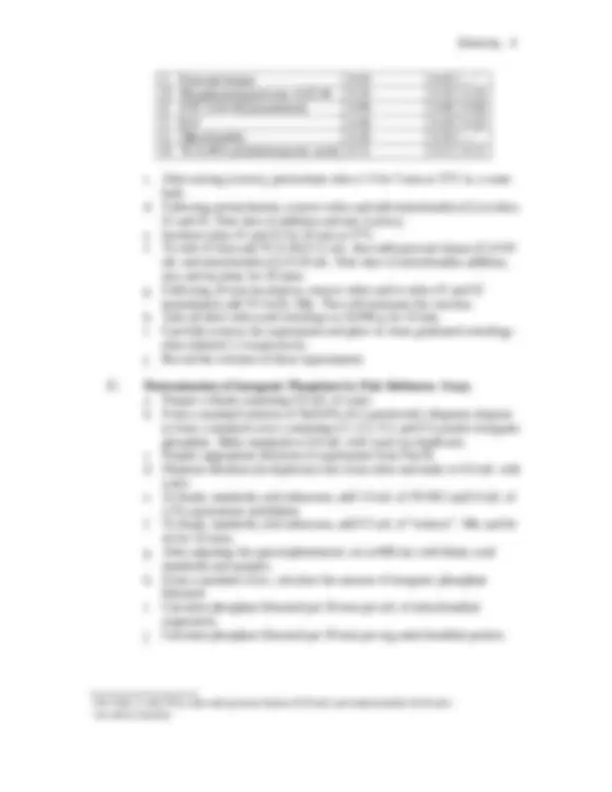
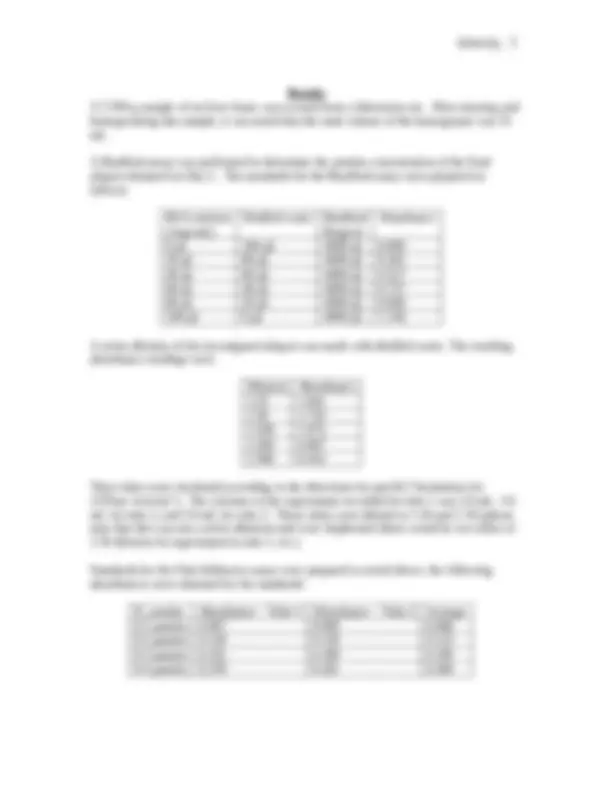
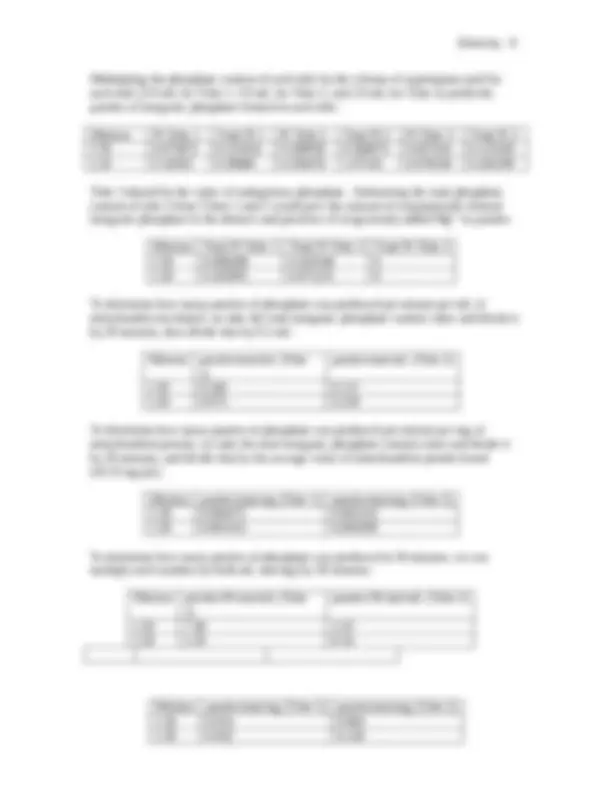
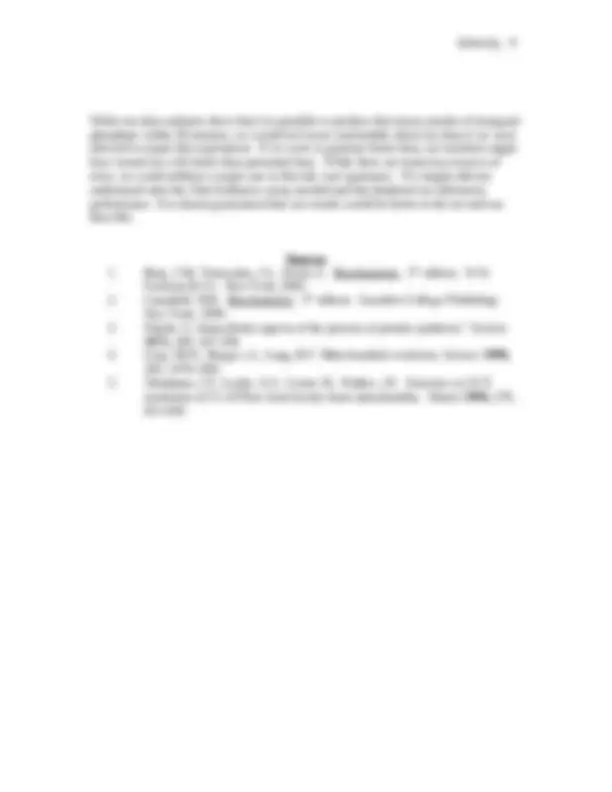


Study with the several resources on Docsity

Earn points by helping other students or get them with a premium plan


Prepare for your exams
Study with the several resources on Docsity

Earn points to download
Earn points by helping other students or get them with a premium plan
Community
Ask the community for help and clear up your study doubts
Discover the best universities in your country according to Docsity users
Free resources
Download our free guides on studying techniques, anxiety management strategies, and thesis advice from Docsity tutors
Details of an experiment aimed at isolating mammalian mitochondria and assessing mitochondrial atpase activity. Background information on mitochondria, their structure, and their role in oxidative phosphorylation. It also outlines the materials used in the experiment and the procedures for mitochondrial isolation and atpase activity measurement.
Typology: Study Guides, Projects, Research
1 / 9

This page cannot be seen from the preview
Don't miss anything!






Jim Zubricky Thursday, 15 April 2004 BIOL 515: Th 9:30-1:
Introduction The objective of this experiment was to isolate mammalian mitochondria and to assess mitochondrial ATPase activity. According to Berg, Tymoczko, and Stryer, mitochondria “are oval-shaped organelles, typically about 2 μm in length and 0.5 μm in diameter.” Two scientists, Eugene Kennedy and Albert Lehninger, discovered that “…mitochondria contain the respiratory assembly, the enzymes of the citric acid cycle, and the enzymes of fatty acid oxidation” (1). It is in mitochondria that oxidative phosphorylation takes place. Mitochondria can be considered the “powerhouse” of the cell; it is here where “26 of the 30 molecules of ATP” are formed “…when glucose is completely oxidized to CO 2 and H 2 O” (2). Electron microscopy studies done by George Palade and Fritjof Sjostrand revealed that mitochondria have two membrane systems: an outer membrane and anextensive, highly folded inner membrane (where these folds (or internal ridges) are called cristae) (3). It is here, in the inner membrane, where oxidative phosphorylation takes place. Mitochondria, in an evolutionary sense, are “semiautonomous organelles that live in anendosymbiotic relationship with the host cell.” This ‘event’ happened when “a free- living organism capable of oxidative phosphorylation was engulfed by another cell” (4). ATP synthase is a protein complex that attaches itself to the mitochonfial matrix and acts as a proton pump, pumping protons from one side of the matrix to the other. This complex can also be called mitochondrial ATPase because it can catalyze the reverse reactions in the mitochondria (5). Materials The materials used in this experiment include: Dissecting equipment 0.9% NaCl Ice and ice buckets 50 mL polycarbonate tubes 15 mL Corex tubes Test tubes and pipets Spectrophotometer Mitochondrial medium (0.24 M sucrose, 0.05 M EDTA, 0.15% bovine serum albumin) 15 mL graduated centrifuge tubes tissue homogenizers 0.4 M Tris-HCl (pH 7.5) 0.4 N MgSO 4 Pyruvate kinase (~ 2 mg/mL) 0.05 M Phosphoenolpyruvate 0.04 M ATP (neutralized) 40% Trichloroacetic Acid NaH 2 PO 4 (0.2^ μmoles/mL) 2.5% Ammonium Molybdate
C. Pyruvate kinase 0.03 0.03 -- 1 D. Phosphoenolypyruvate, 0.05 M 0.10 0.10 0. E. ATP, 0.04 M (neutralized) 0.06 0.06 0. F. H 2 O 0.40 0.20 0. G. Mitochondria 0.20 0.20 -- 1 H. TCA 40% (tricholoroacetic acid) 0.11 0.11 0. c. After mixing (vortex), preincubate tubes 1-3 for 5 min at 37oC in a water bath. d. Following preincubation, remove tubes and add mitochondria (G) to tubes #1 and #2. Note time of addition and mix (vortex). e. Incubate tubes #1 and #2 for 20 min at 37oC. f. To tube #3 first add TCA (H) 0.11 mL, then add pyruvate kinase (C) 0. mL and mitochondria (G) 0.20 mL. Note time of mitochondria addition, mix and incubate for 20 mins. g. Following 20 min incubation, remove tubes and to tubes #1 and # immediately add TCA (H). Mix. This will terminate the reaction. h. Take all three tubes and centrifuge at 10,000 g for 10 min. i. Carefully remove the supernatant and place in clean graduated centrifuge tubes labeled 1-3 respectively. j. Record the volumes of these supernatants. C. Determination of Inorganic Phosphate by Fisk-Subbarow Assay a. Prepare a blank containing 6.0 mL of water. b. From a standard solution of NaH 2 PO 4 (0.2 μmoles/mL) dispense aliquots to form a standard curve containing 0.1, 0.2, 0.3, and 0.4 μmoles inorganic phosphate. Make standards to 6.0 mL with water (in duplicate). c. Prepare appropriate dilutions of supernatant from Part B. d. Dispense dilutions (in duplicate) into clean tubes and make to 6.0 mL with water. e. To blank, standards, and unknowns, add 1.0 mL of 5N HCl and1.0 mL of 2.5% ammonium molybdate. f. To blank, standards, and unknowns, add 0.5 mL of “reducer”. Mix and let sit for 10 mins. g. After adjusting the spectrophotometer, set at 660 nm with blank, read standards and samples. h. From a standard curve, calculate the amount of inorganic phosphate liberated. i. Calculate phosphate liberated per 30 min per mL of mitochondrial suspension. j. Calculate phosphate liberated per 30 min per mg mitochondrial protein. (^1) For Tube 3: Add TCA, then add pyruvate kinase (0.03 mL) and mitochondrial (0.20 mL) (^1) see above footnote.
Results A 5.594 g sample of rat liver tissue was excised from a laboratory rat. After mincing and homogenizing this sample, it was noted that the total volume of the homogenate was 55 mL. A Bradford assay was performed to determine the protein concentration of the final aliquot obtained on Day 1. The standards for the Bradford assay were prepared as follows: BSA solution (1mg/mL) Distilled water Bradford Reagent Absorbance 0 μL 100 μL 4000 μL 0. 20 μL 80 μL 4000 μL 0. 40 μL 60 μL 4000 μL 0. 60 μL 40 μL 4000 μL 0. 80 μL 20 μL 4000 μL 0. 100 μL 0 μL 4000 μL 1. A series dilution of the investigated aliquot was made with distilled water. The resulting absorbance readings were: Dilution Absorbance 1:25 1. 1:50 1. 1:100 1. 1:200 0. 1:500 0. Three tubes were incubated according to the directions for part B (“Incubation for ATPase Activity”). The volumes of the supernatant recorded for tube 1 was 2.6 mL, 3. mL for tube 2, and 3.0 mL for tube 3. These tubes were diluted to 1:20 and 1:50 (please note that this was not a series dilution) and were duplicated (there would be two tubes of 1:50 dilution for supernatant in tube 1, etc.). Standards for the Fisk-Subbarow assay were prepared as noted above; the following absorbances were obtained for the standards: Pi, μmoles Absorbance – Tube 1 Absorbance – Tube 2 Average 0.1 μmoles 0.067 0.069 0. 0.2 μmoles 0.120 0.126 0. 0.3 μmoles 0.191 0.189 0. 0.4 μmoles 0.259 0.261 0.
we had a 1:25 dilution, we have to multiply that concentration by 25 so that each of the concentrations would be on equal footing, as it were.): Dilution Absorbance Concentration (μg/ μL) Correction Factor Corrected Concentration 1:25 1.941 176.858 25 4421. 1:50 1.710 155.066 50 7753. 1:100 1.073 94.9717 100 9497. 1:200 0.697 59.5 200 11900. 1:500 0.452 36.3868 500 18193. Average Value ^ 10353.1 μg/ μL The average protein concentration is 10353.1 μg/μL, or 10.35 mg/μL. Determination of Inorganic Phosphate Graphing the standards from the Fisk-Subbarow assay gives: Fisk-Subbarow Assay: Determination of Inorganic Phosphate y = 0.643x - 0. R^2 = 0. 0
0 0.05 0.1 0.15 0.2 0.25 0.3 0.35 0.4 0. umoles of inorganic phosphate Absorbance with a trendline of y = 0.643x – 0.0005, and an R^2 value of 0.9971. By using this equation, we can determine the amount of μmoles of inorganic phosphate produced: Dilution Tube 1 Pi Tube 1 Tube 2 Pi Tube 2 Tube 3 Pi Tube 3 1:50 0.048 0.073872 0.122 0.188958 0.031 0. 1:20 0.107 0.16563 0.231 0.358476 0.051 0.
Multiplying the phosphate content of each tube by the volume of supernatant used for each tube (3.0 mL for Tube 1, 3.0 mL for Tube 2, and 2.6 mL for Tube 3) yields the μmoles of inorganic phosphate formed in each tube: Dilution Pi Tube 1 Total Pi 1 Pi Tube 2 Total Pi 2 Pi Tube 3 Total Pi 3 1:50 0.073872 0.221616 0.188958 0.566874 0.047434 0. 1:20 0.16563 0.49689 0.358476 1.07543 0.078538 0. Tube 3 should be the value of endogenous phosphate. Subtracting the total phosphate content of tube 3 from Tubes 1 and 2 would give the amount of enzymatically formed inorganic phosphate in the absence and presence of exogenously added Mg2+^ in μmoles: Dilution Total Pi Tube 1 Total Pi Tube 2 Total Pi Tube 3 1:50 0.098288 0.443546 0 1:20 0.292691 0.871231 0 To determine how many μmoles of phosphate was produced per minute per mL of mitochondria incubated, we take the total inorganic phosphate content value and divide it by 20 minutes, then divide that by 0.2 mL: Dilution μmoles/min/mL (Tube
μmoles/min/mL (Tube 2) 1:50 0.246 0. 1:20 0.073 0. To determine how many μmoles of phosphate was produced per minute per mg of mitochondrial protein, we take the total inorganic phosphate content value and divide it by 20 minutes, and divide that by the average value of mitochondrial protein found (10.35 mg/μL): Dilution μmoles/min/mg (Tube 1) μmoles/min/mg (Tube 2) 1:50 0.000475 0. 1:20 0.001414 0. To determine how many μmoles of phosphate was produced in 30 minutes, we can multiply each number (in both mL and mg) by 30 minutes: Dilution μmoles/30 min/mL (Tube
μmoles/30 min/mL (Tube 2) 1:50 7.38 3. 1:20 2.19 6. Dilution μmoles/min/mg (Tube 1) μmoles/min/mg (Tube 2) 1:50 0.014 0. 1:20 0.042 0.